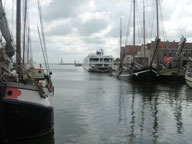Europeanbarging presents Arosa Cruises to Hoorn on the Arosa Flora and Silva
Hoorn is a town in North Holland and was once the capital of West Friesland. It features many beautiful houses from the Golden Age, when the Dutch East India and the West India Companies had offices here. Cape Horn, is the the most southerly point of the Americas and was discovered by Willem Schouten The cape was named after his home town. Another famous explorer from Hoorn was Jan Coen, who founded Jakarta in Indonesia.
Enjoy a stroll along the Hoorn Harbor and see the diversity of ships in the harbor. There are some very old sailing vessels that are still sailed today. As you walk into town there is a fortified gate from 1532 that was originally a defense tower. It was named Hoofdtoren, In front of Hoofdtoren stands a wooden landing made in 1464 named the Houten Hoofd. In 1651 a bell tower was constructed on top of the tower. The lock to the main harbor dates back to 1778. There are several canals leading from the main town and many shops and bars at the harbor. Walking along the cobbled and brick streets and along the canals you will find lots of interesting architecture and shops. While we were in Hoorn there was a world soccer game going on and I think the whole town was in a bar at the harbor so we had the whole town to explore mostly on our own. Everyone started coming out of the bar as we headed back to our ship and they were in good spirits leading us to think their team won.
Sites of interest include Staten Parliament, built in 1632 and located in the town square – Rode Steen. It is now the Westfries Museum. The museum has an extensive collection of paintings, silver objects, porcelain, historic firearms etc. The exhibition of this vast collection covers 25 rooms, one of which is a style-room. In 1953, 15th century cellars were discovered under the building. These cellars are now part of the exhibition for archaeological objects from Hoorn and its surroundings.
St. Jans Gasthuis museum holds temporary exhibits. Near this museum is the Bossehuizen which is a collection of 3 houses built in 1612 and featuring friezes depicting the defeat of the Spanish Admiral Bossu in 1573.
Arosa offers 2 Northern Rhine itineraries that stop in Hoorn. The 7 night Experience the Northern Rhine cruising Holland and Belgium, and the 9 night Experience the Rhine and the Sea, which cruises northern Holland as well and Holland and Belgium. April departures on these North Rhine River cruise itineraries include Amsterdam and the Keukenhof Gardens. Rates from $1484 for 7 night. Rates include all meals, beverage package, Wi-Fi and use of the ship’s fitness and spa facilities.
Taking in this fabulous city of historical and architectural wonders will be a great delight. Book your trip with us today! Europeanbarging.com 888-869-7907

